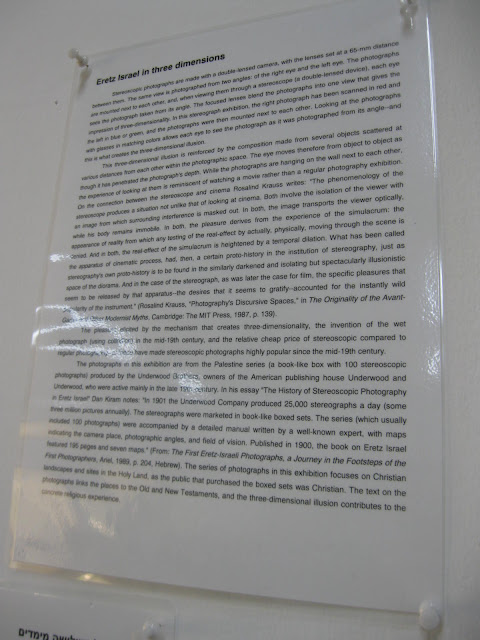For ABC Wednesday, D is for Dina in 3-D glasses.
Dozens of glasses wait for visitors and pupils who come to the Open Museum in Omer.
You can't see them properly, of course, but here are some examples of the big three-dimensional photographs taken in Eretz Israel in the late 19th century.
Here above is Jerusalem's Jaffa Gate when it still had the Ottoman clock tower just outside the Old City wall (the tower was soon torn down by the British in 1922).
This is labeled "Ancient Fountain of the Virgin, Nazareth, Palestine."
It was fascinating to gaze at these pictures; I felt like I was really "in" the scene, mingling with the women and children.
Fallahin plowing.
"Tiberias, a town of Jewish fisherman, Sea of Galilee"
Please click on the photo and then once again.
You can read how stereographs were made and how American publishing house Underwood and Underwood produced and sold the set about Eretz Israel in 1900, focusing mostly on the Christian market.
.









I've used those glasses in the odd museum exhibit- they do seem to bring the image into more depth.
ReplyDeleteThe image as it is does end up looking odd without them!
What an ingenious find that is, isn't it? Lovely post !!
ReplyDeleteHave a nice abc-day / - week
♫ M e l ☺ d u ♫ (abc-w-team)
How absolutely DELIGHTFUL...great post.
ReplyDeleteLeslie
abcw team
Can you put glasses on a camera? I wonder if your camera could see in 3-D.
ReplyDeleteInteresting how this works.
ReplyDeleteWhat a nice idea to attrack specially young people to a museum. Nice blog!
ReplyDeleteLiesbeth ABCWT
Goodness I've not heard about using 3D with photographs Dina, movies yes, but still photos no. I did read the process that creates the 3D effect, incredibly complicated. It is indeed a good way to attract a younger audience to the museum.
ReplyDeleteI remember playing with stereoscopes as a child. I think we still have a couple of Art's collections in storage somewhere.
ReplyDelete3D movies give me a headache!
ReplyDeleteROG, ABCW